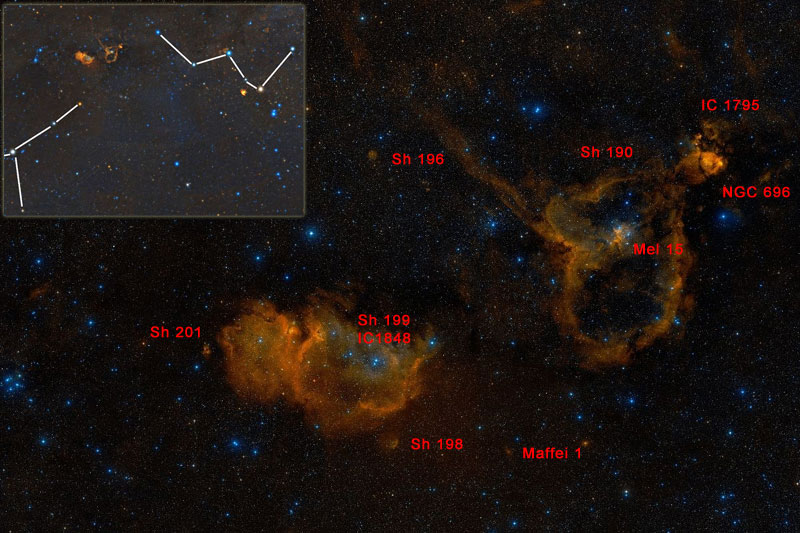
| einführung | observing guide | objekte sommer | objekte winter | daten |
sharpless objekte winter
The Big Picture: Sharpless in the Heart and Soul area at the Cassiopeia/Perseus border
This image stretches over 7° of sky in the Cassiopeia/Perseus region and gives you a grand view of the Sharpless nebula in this area.
![]()
|
Sharpless 190 This is the Heart Nebula complex around the open cluster Melotte 15. The Heart Nebula is a huge HII region just north of the h/chi Double Cluster, consisting of several single nebula. It responds well to all nebula filter (UHC, OIII, H beta) with a slight advantage to the OIII filter. The brightest region is the north-western part, comprising NGC 896 and IC 1795 as a smaller bright one and a larger, somewhat fainter patch. Panning towards SE leads to the distinct open cluster Melotte 15, which is in the heart of the Heart and will be our starting point for further exploration. Mel 15 is surrounded by nebulosity which bears the designation IC 1805. This part extends from Mel 15 somewhat towards E. Besides this central part, there are other regions of interest: A quite distinct arc passes the cluster on its north side. Another one passes more distant on its southern side, becomes SE of the cluster fainter, turns then towards north and becomes again more distinct. A third stretch of nebulosity extends straight from the eastern part of the central IC 1805 towards NE and can be followed over a quite large distance with filter.
field size 4° |
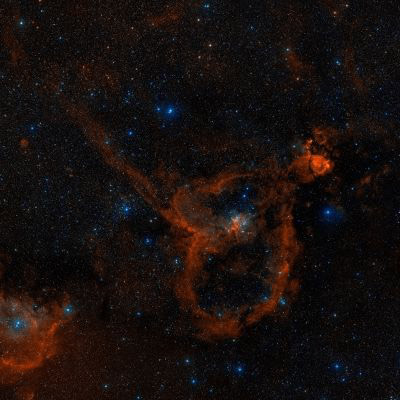 |
|
Sharpless 199 This is the highly obscured galaxy Maffei 1. Maffei 1 is easily visible as a distinct diffuse and elongated glow behind a loose OC.
|
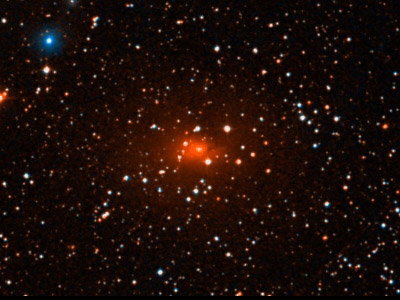 |
|
Sharpless 199 This is the Embryo Nebula IC 1848. Similar in brightness to the Heart Nebula. Best with OIII, divided into two parts, SW part is larger and was suspected to be brighter at the borders, NE part is smaller, round and filled with neb.
field size 4° |
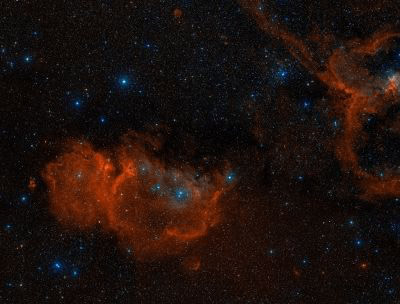 |
|
Sharpless 200 This is the large PN HDW 2. At 100x with OIII filter, HDW2 is a very faint round patch, somewhat larger than the arc of stars in the center. Offset towards NE from the star chain.
field size 0.5° |
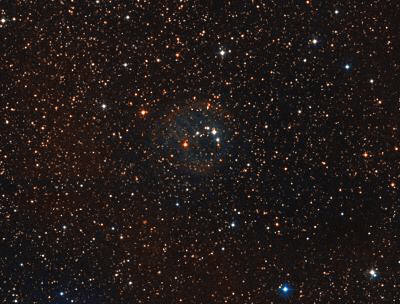 |
|
Sharpless 206 This is a relatively bright nebula next to star.
field size 1° |
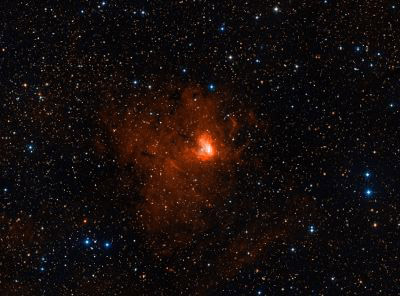 |
|
Sharpless 207 and 208 Sh 207 (upper) is visible at 200x w/o filter as a small open cluster. With UHC filter, a small nebula surrounds these stars. Was misclassified as PN. Sh 208 (lower) appears at 200 and 350x w/o filter as a small compact glow around two stars. Appears to be mostly reflection nebula as UHC and even more OIII reduce visibility.
field size 0.3° |
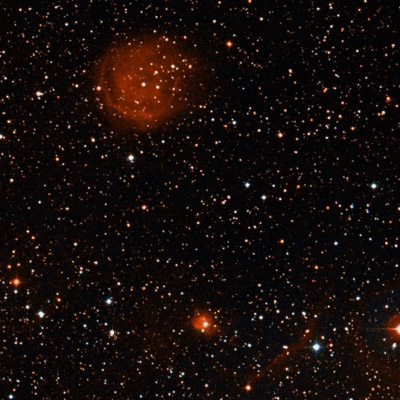 |
|
Sharpless 211 At 200x with UHC filter, a faint glow is visible around a small group of stars.
field size 0.5° |
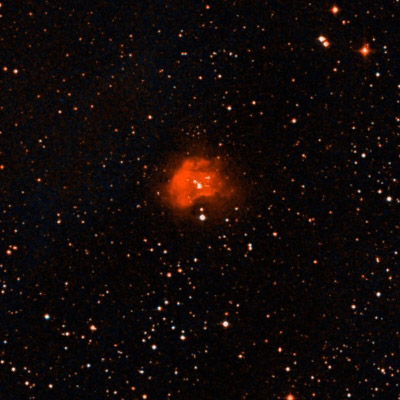 |
|
Sharpless 212 At 200x with OIII, a distinct round brightening around stars, relatively well defined boundaries.
field size 0.5° |
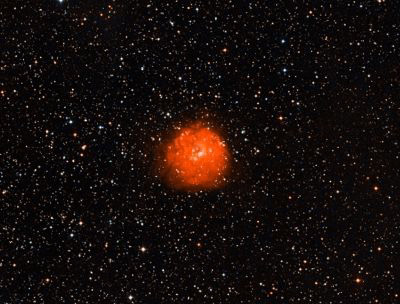 |
|
Sharpless 216 This is the largest known planetary nebula. At 50x with OIII filter, the NE edge could be observed and showed the highest contrast to the background The NE edge is also distinct in my 80mm finder equipped with UHC filter, but very difficult in my 22" Dob due to the restricted field.
field size 3° |
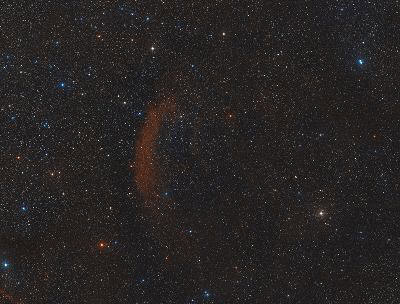 |
|
Sharpless 217 At 100x with H beta filter, a faint glow, elongated in SE-NW direction, is visible along a small chain of stars (between the two brighter stars)
field size 0.5° |
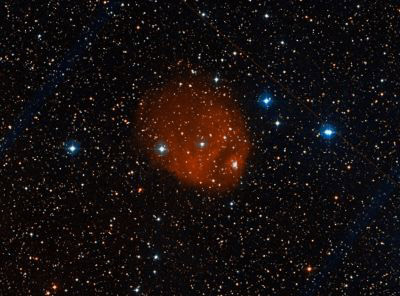 |
|
Sharpless 220 This is the California Nebula NGC 1499. Extremely large EN, responds best to H beta. Well visible with my 80 mm finder and UHC filter.
field size 5° |
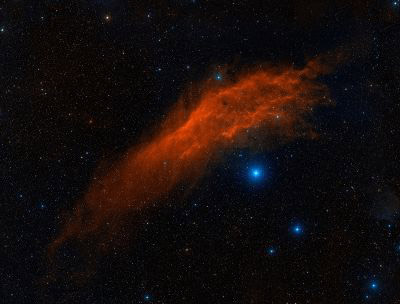 |
|
Sharpless 222 Mostly RN, best w/o filter, structured glow, after some time a dark band could be discerned as well as another nebulous patch to the NE.
field size 1° |
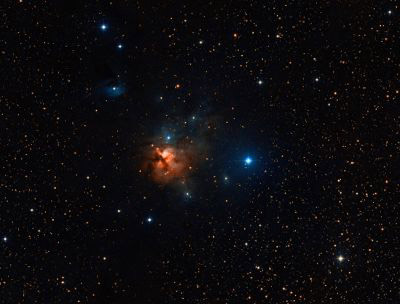 |
|
Sharpless 223 This is the supernova remnant SNR 166.2+02.5 in Auriga. Up to now unsucessful observations only.
field size 2° |
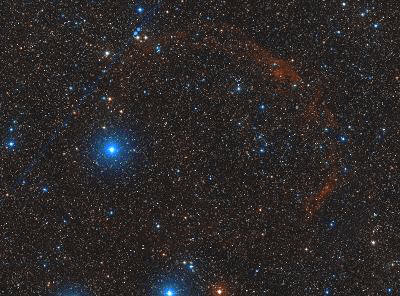 |
|
Sharpless 224 Another supernova remnant in Auriga. With OIII filter a faint filament was suspected at the N edge of the SNR. Doubtful observation.
field size 1.5° |
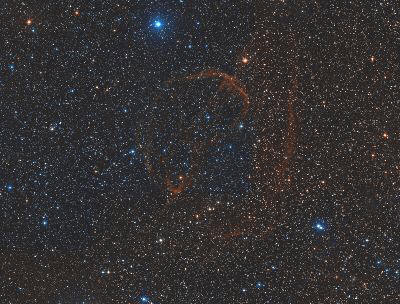 |
|
Sharpless 228 At 350x w/o filter, a faint diffuse glow cold be seen around star pattern. Slightly displaced relative to the star pattern.
field size 0.2° |
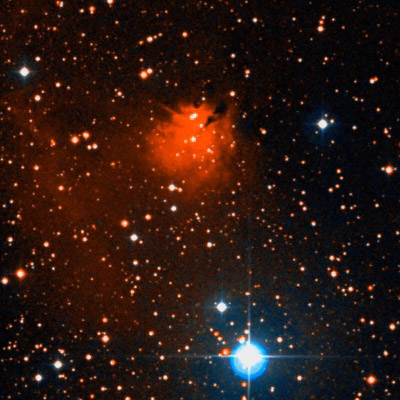 |
![]()
The Big Picture: Sharpless in the Auriga region
This image stretches over 10° of sky in the Auriga region and gives you a grand view of the Sharpless nebula in this area.
![]()
|
Sharpless 229 The Flaming Star nebula, IC 405, is excited by the runaway O9.5Ve star AE Aurigae, which is believed to originate from Orion Nebula cluster. At 100x with H beta, a distinct milky glow was observed NW of AE Aur. The long extension toward S west of AE was suspected.
field size 2° |
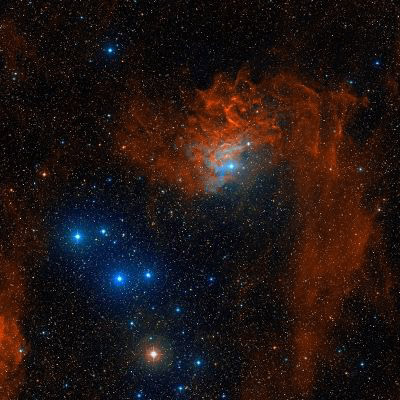 |
|
Sharpless 230 At 100x with H beta, Sh 230 could be detected as an extremely faint milky streak oriented NE-SW
field size 2° |
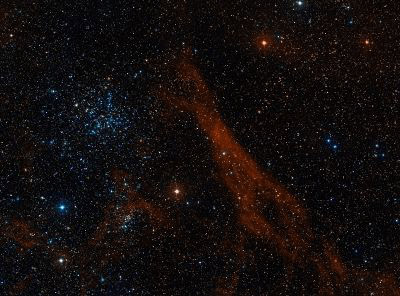 |
|
Sharpless 231/232/233/235 Observed several times. Sh235 is distinct with or without filter around star. Sh231, 232 and 233 could not be observed.
field size 2° |
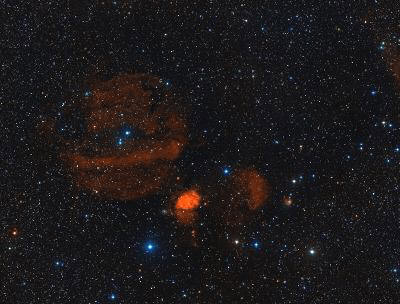 |
|
Sharpless 236 Despite being not listed in either the Messier catalog nor the NGC, IC 410 is a very conspicuous and bright emission nebula in Auriga. With UHC or OIII filter, it is distinctly visible from my suburban backyard using my small 4.5" reflector. The Tadpoles in IC 410 are so-called globules, which may be the birthplace of new stars. These globules are eroded by the radiation pressure of the central star cluster. The side of the globule that faces the cluster is excited and is visible as a bright rim.
Despite there are many beautiful
pictures of these tadpoles, as for instance by Richard Crisp
field size 1° |
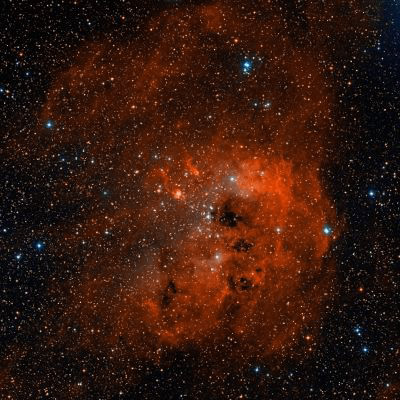
|
|
Sharpless 234 and 237 This is IC 417, the Spider Nebula and NGC 1931, the Fly. With OIII filter, IC 417 appears as a weak and diffuse, but distinct glow around small OC Stock 8. NGC 1931 is a very small and diffuse bright nebula, well visible w/o filter.
field size 2° |
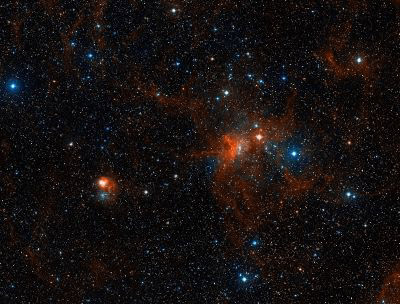 |
|
Sharpless 238 Hind's Nebula, NGC 1555, is part of the envelope around the young star T Tauri, prototype of the T Tauri class of young stellar objects (YSOs), reflecting a certain phase of high variability during the early development of stars similar to our sun. The variability of T Tauri is the reason for the variability of its surrounding nebula. While it used to be a relatively bright object around 1852, when John Hind discovered it using a 7-inch refractor, it was all but invisible only 15 years later and was not re-observed until the end of the 19th century. At present, Hind's Variable Nebula is relatively constant at a low level and hence a rather difficult object, that requires aperture and good conditions. If you know what to look for, you're already halfway there. The nebula appears as a very faint and unexpectedly large crescent bending around one side of T Tauri. Under excellent conditions, a splitting of its southern end could be observed and later verified on photographs. The neighboring "double star" may help a lot to get an idea about size of the faint crescent and its distance to T Tauri. In the same direction from T Tauri, but somewhat more distant, Otto Wilhelm Struve described in 1886 another nebula, NGC 1554, that was confirmed by d'Arrest. Whatever it was, it is no longer visible today even in the deepest photographs and possibly never was ("Struve's Lost Nebula").
field size 0.2° |
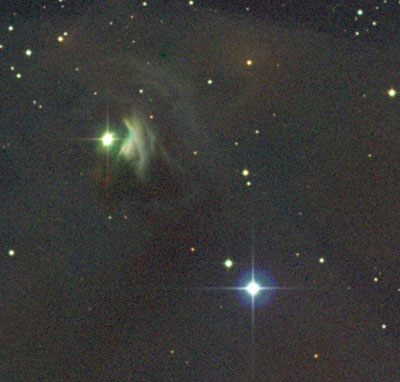 |
|
Sharpless 239 Another star forming region with several YSOs and HHs. Under excellent conditions well visible at 200x w/o filter as a round faint diffuse glow.
field size 0.5° |
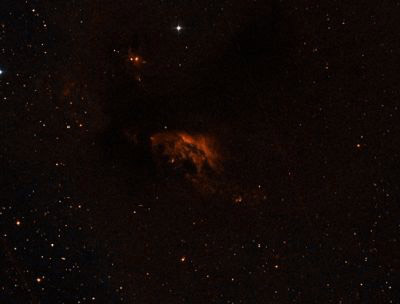 |
|
Sharpless 240 This is the huge supernova remnant Simeis 147 at the Taurus/Auriga border. Up to now no firm observation.
field size 5° |
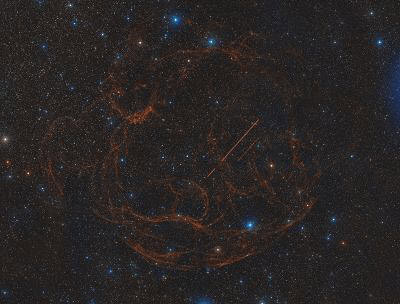 |
|
Sharpless 242 At 100x with either UHC or H beta, an extremely faint glow was suspected. With UHC, glow was suspected mainly E of star, with H beta displaced to SW relative to star.
field size 0.3° |
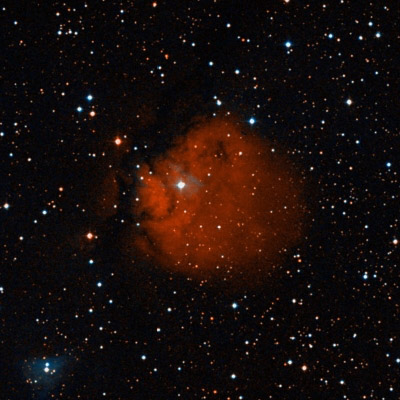 |
|
Sharpless 244 This is the Crab Nebula, the remnant of the 1054 supernova. With 7mm and UHC filter, the filaments are faintly visible, superimposed on the z-shaped synchrotron nebula, which is due to its broadband nature not responding to line filters. With a polarization filter, the polarization of the synchrotron radiation is susceptible. The shape of the synchrotron nebula changes slightly depending on filter orientation. This is most evident at the SE and NW extensions of the Z. Image by Dean Salman.
field size 0.2° |
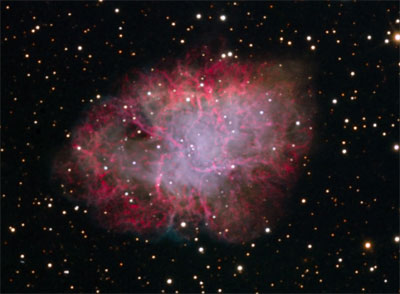 |
|
Sharpless 245 This is part of the Eridanus Loop, the western counterpart to Barnard's Loop. Even under sub-optimal conditions, this long filament was visible with H beta filter at 7mm exit pupil, when sweeping over it. Largest contrast immediately west of a Y shaped asterism in the middle of above picture. Also extremely faint in 4" binoculars equipped with H beta filters. This part of the Eridanus bubble is fainter than the brightest part of Barnards loop, NE of M78. More about this is here.
HII image by Dean Salman.
field size 2° |
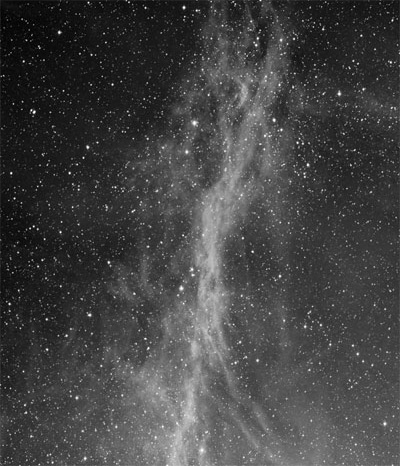 |
![]()
The Big Picture: Sharpless at the Gemini-Orion border
This image stretches over 10° of sky in the Gemini-Orion region and gives you a grand view of the Sharpless nebula in this area.
![]()
|
Sharpless 248 This is the supernova remnant IC 443 in Gemini. At 100x with OIII. The NE front appears as a long structured filament, which is sharply outlined toward NE, but appears "filled" on the other side. SW filament is extremely faint, visible only with UHC filter, crossing an obvious rectangle of stars SE of Eta Gem. field size |
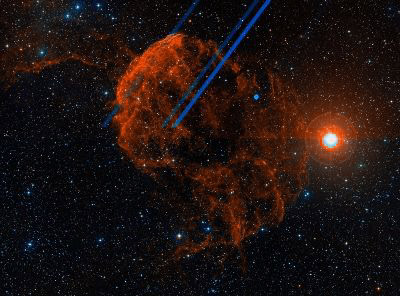 |
|
Sharpless 252 This is the Monkey Head Nebula NGC 2174/75, IC2159. Very bright nebula, visible already in my 8" without filter or in my 80mm finder with UHC as a large round glow around a bright star in the middle. Responds extremely well to OIII filter. Very structured with 22" with a well defined dark band penetrating from NW into the nebula with a superimposed chain of stars. Another more diffuse dark wedge is on the E side.
field size 1.5° |
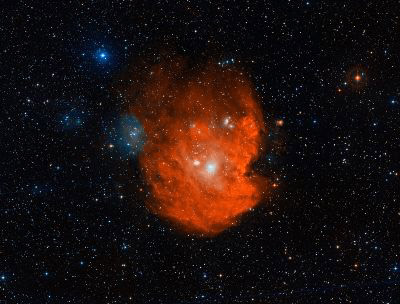 |
|
Sharpless 254 and friends These are the Three Snowballs in Orion, comprising as well Sh 255, 256, 257, and 258. In the 24 mm eyepiece of my 22-Inch Dob, the two more compact nebula 255 and 257 were easily visible with H-Beta filters as milky, well defined areas, each surrounding a star in the middle. Sharpless 254 was somewhat more diffuse, but could be seen without retinal torture. The entire group fit into the field of view of the eyepiece and the contrast between the diffuse 254 and the more compact 255 and 257 was particularly beautiful. With the UHC Filter, all three were still visible, yet much more difficult than with H-Beta. As to be expected for low-excitation HII regions, they were not visible with the OIII filter. After I had enjoyed the view of the group for some time, I shortly tested the small nebula Sharpless 258, which is to the left on the image. As there was nothing visible immediately, I did not try to push this, in particular as there are superimposed stars, which might be deceiving. Sh256, on the other hand, was well visible as a separate glow detached from the main mass of Sh257. field size 0.5° |
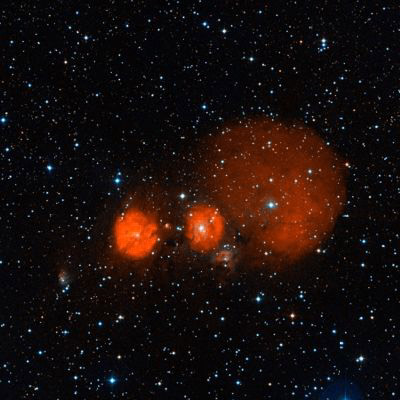 |
|
Sharpless 261 This nebula also bears the name Lower's Nebula.
At 100x, this is a fairly faint nebula as compared to its brightness on the DSS. Responds both to OIII in the central part and to H beta in the outer parts (roughly marked in the DSS red image to the right). A large H beta region is N of the central part.
Narrowband image by Dean Salman.
field size 1.5° |
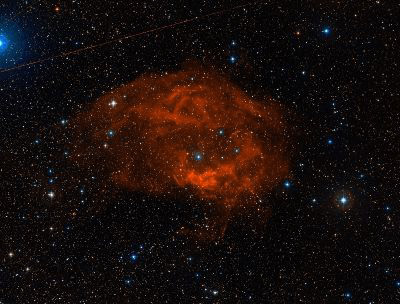
|
|
Sharpless 264 This is a huge and faint HII region around Meissa, Lambda Ori.
field size 12° |
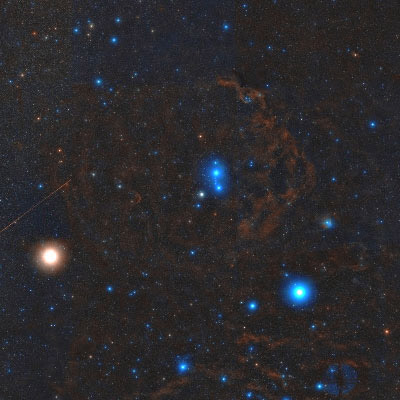 |
|
Sharpless 265 This is at the SW edge of Sharpless 264, the faint HII region around Meissa, Lambda Ori. A faint contrast was suspected along the northern edge with H beta filter. H-alpha image by Dean Salman. field size 12° |
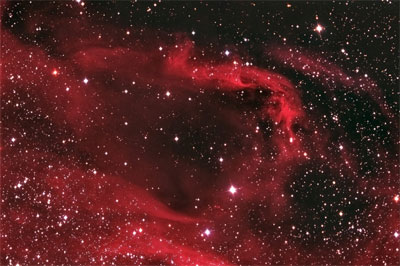 |
|
Sharpless 269 At 200x, without filter, a faint glow was visible, that did not respond well to UHC. Probably mostly reflection nebula.
field size 0.2° |
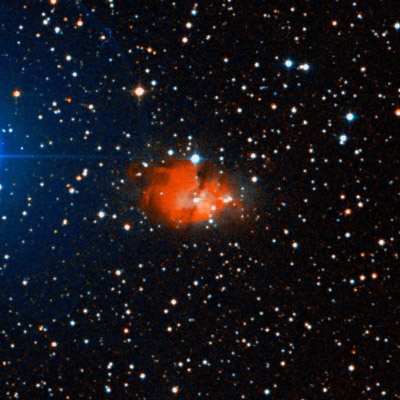 |
|
Sharpless 270 Appears at 350x w/o filter as a small round patch.
field size 0.1° |
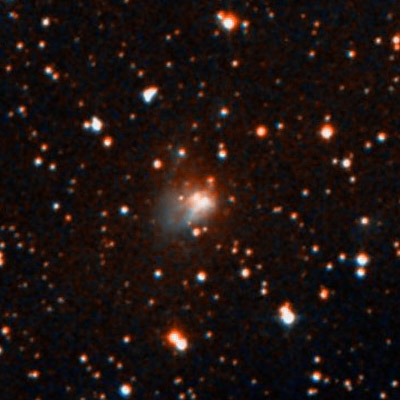 |
![]()
The Big Picture: Sharpless in the Monoceros region
This image stretches over 15° of sky in the Monoceros region and gives you a grand view of the Sharpless nebula in this area.
![]()
|
Sharpless 273 This is the region of the Fox Fur Nebula in the Christmas Tree Cluster around S Mon and the Cone Nebula. The RNe around S Mon are easily visible w/o filter. The cone nebula was observed several times with H beta filter. Not symmetrical to the tip of the Christmas tree, the E side (with further nebulosity towards E) is slightly better defined than W side. Both sides are visible, but extremely faint, forming the shilouette of the cone.
field size 1° |
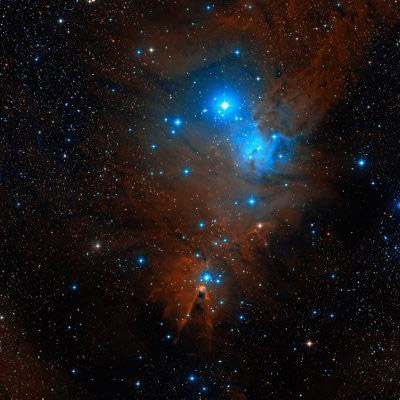 |
|
Sharpless 274 This is the large planetary nebula Abell 21. The most beautiful ear of the universe! Responds very well to OIII filter. E side forms filamentous crescent, which is relatively bright in OIII. Inside filled with weaker OIII emission. NW counterpart also visible as an extremely faint crescent along chain of stars, forms with E crescent a closed structure.
field size 0.5° |
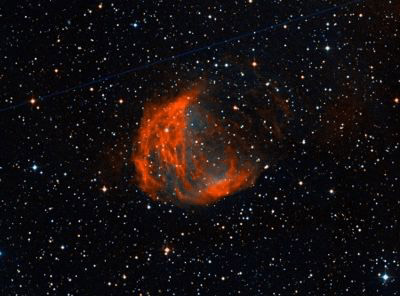 |
|
Sharpless 275 This is the Rosette Nebula NGC 2246. Extremely detailed EN with several superimposed dark lanes.
field size 2° |
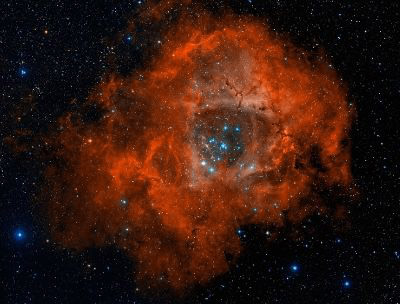 |
|
Sharpless 276 This is Barnard's Loop in Orion. The image to the right shows the brightest part in the area of M78. In my 80 mm finder with UHC filter, the area NW of M78 appears fairly distinct as a milky glow.
field size 7.5° |
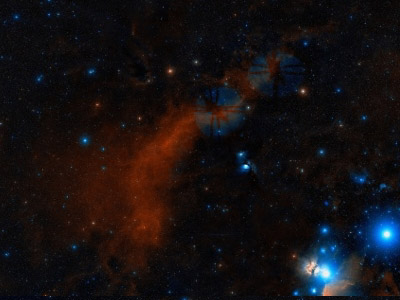 |
|
Sharpless 277 This is the region around Alnitak, comprising the Flame Nebula, IC434 and the Horsehead, as well as several reflection nebula, all of wich are visible best w/o filter, except for IC 434 (H beta).
field size 2° |
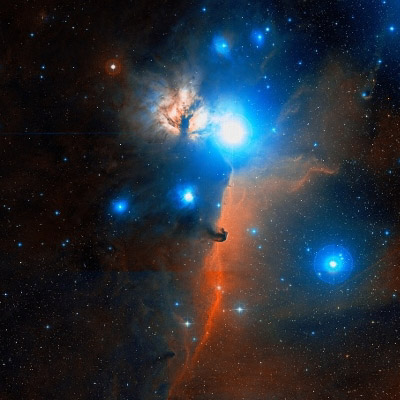 |
|
Sharpless 279 This is the Running Man Nebula, N of the Orion Nebula. Best w/o filter. Image by Dean Salman.
field size 0.5° |
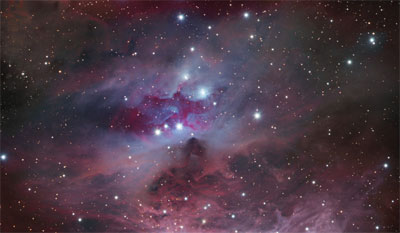 |
|
Sharpless 280 At 7mm exit pupil, a large and faint nebula is visible. Responds equally well to OIII and H-beta filters and somewhat better to UHC. Situated around pair of stars, shifted somewhat toward N from that group, appears heart shaped with two extensions towards SW. Shape relatively well defined.
Narrowband image by Dean Salman.
field size 1° |
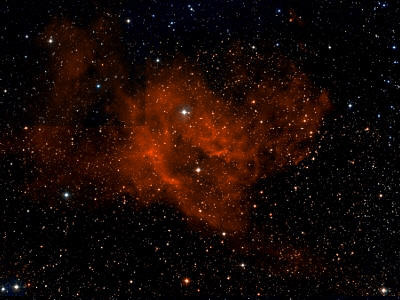
|
|
Sharpless 281 This is the Orion Nebula.
|
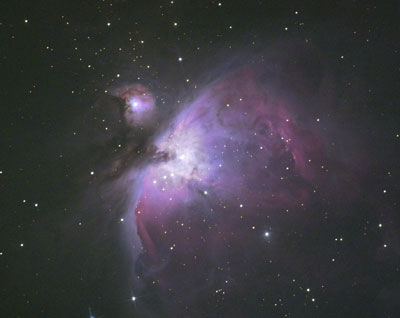 |
|
Sharpless 282 Fairly obvious large structured nebulous area, best visible with 7mm exit pupil and H-beta filter. field size 0.75° |
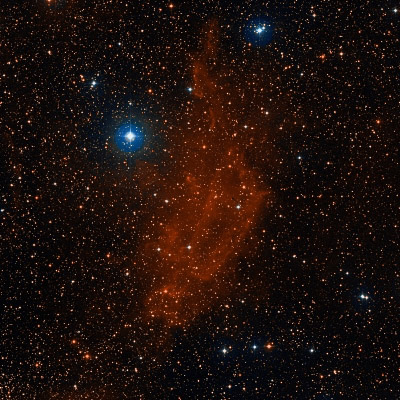 |
|
Sharpless 284 At 80x, a very faint and large diffuse nebula is visible with UHC.
field size 1.5° |
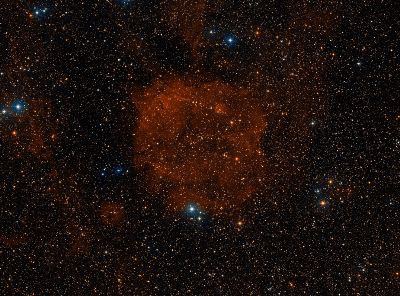 |
|
Sharpless 288 Small and bright patch of light, presumably with RN, UHC > w/o filter, responds hardly to OIII.
field size 0.3° |
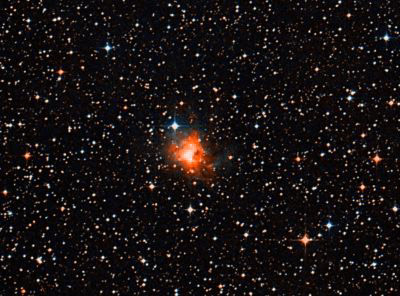 |
|
Sharpless 290 This is the large PN Abell 31 in Cancer. At 100x and with OIII filter, this PN is huge and diffuse with no sharp boundaries. Appears structured, though details are difficult to pin down.
field size 0.7° |
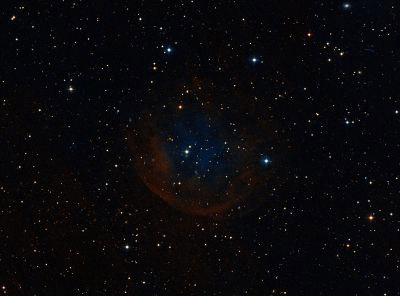 |
|
Sharpless 296 and friends This is the huge complex around the Seagull Nebula IC 2177=Sh296 and comprises Sh 292, 293, 295, and 297. Best with UHC, Ced 90/297 with RN, Gum 1 best with H beta (dark lane). Several RNs are superimposed, Z CMa is nearby. Extremely interesting area.
field size 3° |
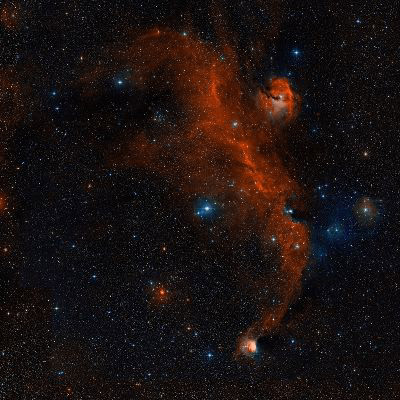 |
|
Sharpless 298 This is the Wolf-Rayet shell NGC 2359, Thor's Helmet. Responds extremely well to OIII filter. Very structured and bright WR nebula with shell, E bar and extensions toward NW and SW.
field size 0.5° |
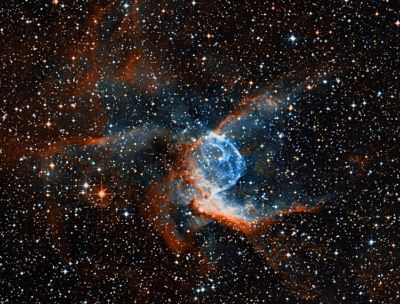 |
|
Sharpless 301 With OIII distinct and structured nebula with dark lane and superimposed stars.
Narrowband image by Dean Salman.
field size 0.7° |
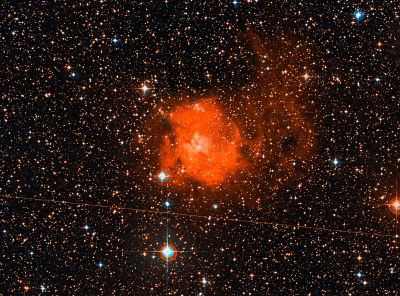
|
|
Sharpless 308 Fantastic Wolf-Rayet bubble around the WR star EZ CMa or WR 6. Responds extremely well to OIII filter. Shell is most obvious as a crescent NW of o1 CMa, becoming fainter at NW. Brighter patch again at N to NE. At 80x under excellent conditions, the shell can be further followed from this N part down the E side back to o1 CMa, forming a closed bubble around EZ CMa. Only with 7mm exit pupil, the center appears filled and somewhat lighter than the outside of the bubble. This is not visible with 5.5mm exit pupil.
image by Marco Lorenzi, www.glitteringlights.com |
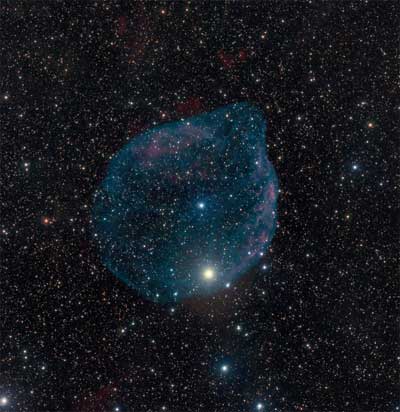 |
|
Sharpless 311 This is the emission nebula/open cluster complex NGC 2467. Already visible w/o filter. OIII > UHC. Central part around star, slightly offset to S. Further parts separated and extending to N and NE. Another extremely large part to E, forming an approximately 30' long crescent open toward NE. Narrowband image by Dean Salman.
field size 1.2° |
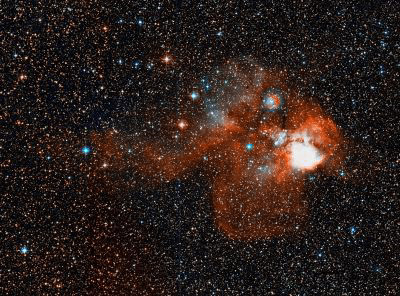
|
|
Sharpless 313 This is the large PN Abell 35 in Hydra. With OIII, diffuse distinct glow around group of three stars. Band at S boundary suspected.
field size 0.5° |
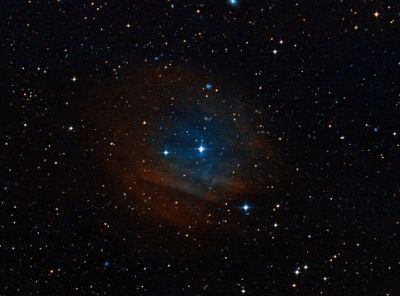 |
![]()
Zu den Beobachtungen aus dem Sharpless-Katalog
| Objekte Sommer | Objekte Winter |
![]()
| einführung | observing guide | objekte sommer | objekte winter | daten |